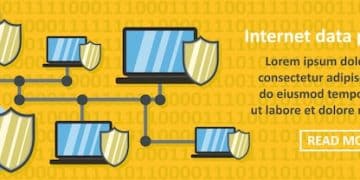Major Cybersecurity Threat Alert: Protecting Your Business from Ransomware Attacks

Protecting your business from the latest ransomware attacks requires a comprehensive cybersecurity strategy, including employee training, robust security software, regular data backups, and proactive threat monitoring to mitigate potential damage.
Navigating the digital landscape requires vigilance, especially with the rising threat of cyberattacks. This article provides essential strategies to safeguard your business against the latest major cybersecurity threat alert: protecting your business from the latest ransomware attacks.
Understanding the Evolving Ransomware Threat Landscape
The realm of cybersecurity threats is constantly evolving, and ransomware remains a persistent and significant danger for businesses of all sizes. Understanding the current landscape is the first step in effectively defending against these attacks.
The Rise of Ransomware-as-a-Service (RaaS)
Ransomware-as-a-Service (RaaS) has lowered the barrier to entry for cybercriminals, making it easier than ever for individuals with limited technical skills to launch sophisticated attacks. RaaS platforms provide a complete toolkit, including the ransomware code, infrastructure, and support services, allowing affiliates to execute attacks and share the profits with the RaaS operator.
The Increasing Sophistication of Ransomware Attacks
Modern ransomware attacks are no longer simple encryption schemes. They often involve multiple stages, including reconnaissance, data exfiltration, and extortion. Cybercriminals are employing advanced techniques, such as double extortion (encrypting data and threatening to release it publicly) and triple extortion (adding DDoS attacks or notifying customers about the breach), to maximize their leverage and increase the likelihood of payment.

Here are key factors that contribute to the evolving ransomware threat:
- Targeting Critical Infrastructure: Cybercriminals are increasingly targeting critical infrastructure, such as healthcare, energy, and transportation, knowing that these organizations are more likely to pay a ransom to restore essential services.
- Exploiting Remote Work Vulnerabilities: The shift to remote work has expanded the attack surface, with many employees using personal devices and unsecured networks, creating new entry points for ransomware infections.
- Using AI and Machine Learning: Cybercriminals are leveraging AI and machine learning to automate and improve their attacks, including identifying vulnerable systems and crafting highly targeted phishing emails.
In conclusion, understanding the evolving ransomware threat landscape, including the rise of RaaS and the increasing sophistication of attacks, is critical for businesses to develop effective defenses and protect their valuable data.
Assessing Your Business’s Cybersecurity Vulnerabilities
Before implementing any security measures, it’s crucial to identify and assess your organization’s specific cybersecurity vulnerabilities. This involves a comprehensive analysis of your IT infrastructure, policies, and procedures to pinpoint weaknesses that could be exploited by attackers.
Performing a thorough risk assessment can help you understand the scope and nature of potential threats, prioritize your security efforts, and allocate resources effectively.
Identifying Potential Entry Points
Start by identifying potential entry points that attackers could use to gain access to your network. This includes evaluating the security of your perimeter defenses, such as firewalls and intrusion detection systems, as well as internal vulnerabilities, such as unpatched software and weak passwords.
Here are some common vulnerabilities to consider:
- Outdated Software: Unpatched software is a major security risk, as attackers often target known vulnerabilities in outdated operating systems, applications, and firmware.
- Weak Passwords: Weak or easily guessable passwords can provide attackers with unauthorized access to accounts and systems.
- Phishing Emails: Phishing emails are a common method for delivering malware and stealing credentials.
Assessing your business’s cybersecurity vulnerabilities is a critical step in building a strong defense against ransomware attacks. By identifying potential entry points and addressing key weaknesses, organizations can significantly reduce their risk of falling victim to cybercrime.
Implementing Robust Security Measures
Once you’ve assessed your vulnerabilities, the next step is to implement robust security measures to protect your business from ransomware attacks. This involves a multi-layered approach that combines technical controls, policies, and employee training to create a strong defensive posture.
A comprehensive security strategy should include the following elements:
- Firewalls and Intrusion Detection Systems: Firewalls act as a barrier between your network and the outside world, blocking unauthorized access and malicious traffic. Intrusion detection systems monitor network traffic for suspicious activity and alert administrators to potential threats.
- Antivirus and Anti-Malware Software: Antivirus and anti-malware software can detect and remove malicious code, including ransomware, from your systems.
- Endpoint Protection: Endpoint protection solutions provide comprehensive security for individual devices, such as laptops and smartphones, protecting them from malware, phishing attacks, and other threats.
Regular Security Audits and Penetration Testing
In addition to implementing these security measures, it’s important to conduct regular security audits and penetration testing to identify any weaknesses in your defenses. Security audits involve a systematic review of your security policies, procedures, and controls, while penetration testing simulates real-world attacks to identify vulnerabilities in your systems and networks.
Implementing robust security measures is essential for protecting your business from ransomware attacks. By combining technical controls, policies, and employee training, organizations can create a strong defensive posture and minimize their risk of falling victim to cybercrime.
Employee Training and Awareness Programs
Employees are often the weakest link in an organization’s security chain, making them prime targets for cybercriminals. With proper education and training, employees can become a valuable asset in the fight against ransomware.
Providing regular security awareness training can help employees recognize and avoid phishing emails, social engineering attacks, and other common tactics used by cybercriminals to deliver ransomware.
Key Topics for Security Awareness Training
Security awareness training should cover a range of topics, including:
- Identifying Phishing Emails: Teach employees how to recognize phishing emails by looking for suspicious sender addresses, grammatical errors, and urgent requests for personal information.
- Password Security: Emphasize the importance of using strong, unique passwords and avoiding the reuse of passwords across multiple accounts.
- Safe Web Browsing: Educate employees about the risks of visiting malicious websites and downloading suspicious files.
In summary, employee training and awareness programs are a critical component of a comprehensive cybersecurity strategy. By investing in employee education, organizations can empower their workforce to become a valuable line of defense against ransomware attacks and other cyber threats.
Data Backup and Disaster Recovery Planning
Even with the best security measures in place, there’s always a risk of a successful ransomware attack. That’s why it’s crucial to have a robust data backup and disaster recovery plan to minimize the impact of an attack and ensure business continuity.
Regularly backing up your data is essential for recovering from a ransomware attack without paying the ransom. Backups should be stored securely and isolated from the primary network to prevent them from being encrypted by the ransomware.
Types of Data Backup Solutions
There are several types of data backup solutions available, including:
Backups should be tested regularly to ensure they can be restored quickly and reliably in the event of an attack.
In conclusion, data backup and disaster recovery planning is a vital component of any cybersecurity strategy. By regularly backing up their data and developing a comprehensive disaster recovery plan, organizations can minimize the impact of a ransomware attack and ensure business continuity.
Responding to a Ransomware Attack
If your business falls victim to a ransomware attack, it’s critical to have a well-defined incident response plan in place to minimize damage and restore operations as quickly as possible.
The first step is to isolate the infected systems to prevent the ransomware from spreading further. This may involve disconnecting the infected devices from the network and shutting down affected servers.
Key Steps in Responding to a Ransomware Attack:
- Isolate Infected Systems: Disconnect infected devices from the network to prevent the ransomware from spreading.
- Notify Law Enforcement: Report the attack to law enforcement agencies, such as the FBI or local police, who may be able to provide assistance with the investigation.
- Restore from Backups: If you have reliable backups, restore your data and systems from the most recent backup.
Responding effectively to a ransomware attack requires a well-defined incident response plan and a coordinated effort from your IT team, management, and legal counsel. By following these steps, organizations can minimize damage, restore operations, and learn from the experience to improve their security posture.
| Key Point | Brief Description |
|---|---|
| 🛡️ Security Measures | Implement firewalls, antivirus software, and intrusion detection systems. |
| 🧑💻 Employee Training | Educate employees to recognize and avoid phishing attempts and malicious links. |
| 💾 Data Backups | Regularly back up data and store backups offline to prevent encryption. |
| 🚨 Incident Response | Develop a plan to isolate infected systems and restore data swiftly. |
Frequently Asked Questions
▼
Ransomware is a type of malicious software that encrypts a victim’s data, rendering it inaccessible, and demands a ransom payment to restore access. It often spreads through phishing emails, malicious attachments, or compromised websites.
▼
Key steps include implementing robust security measures like firewalls and antivirus software, training employees to recognize phishing attempts, regularly backing up data, and keeping software and systems up to date with the latest security patches.
▼
Immediately isolate infected systems to prevent further spread, notify law enforcement, assess the damage, and if possible, restore your data from backups. Avoid paying the ransom as it does not guarantee data recovery and can encourage further attacks.
▼
The frequency of data backups depends on how critical the data is and how often it changes. For most businesses, daily backups are recommended, with less critical data backed up weekly or monthly. Ensure backups are stored securely offline.
▼
Ransomware-as-a-Service (RaaS) is a business model where ransomware developers lease their ransomware tools and infrastructure to affiliates, who then launch attacks. This lowers the barrier to entry for cybercriminals, making it easier to conduct ransomware attacks.
Conclusion
In conclusion, protecting your business from ransomware attacks requires a comprehensive cybersecurity strategy that combines robust security measures, employee training, data backup and disaster recovery planning, and a well-defined incident response plan. By taking these steps, organizations can significantly reduce their risk of falling victim to ransomware and ensure business continuity in the face of cyber threats.





